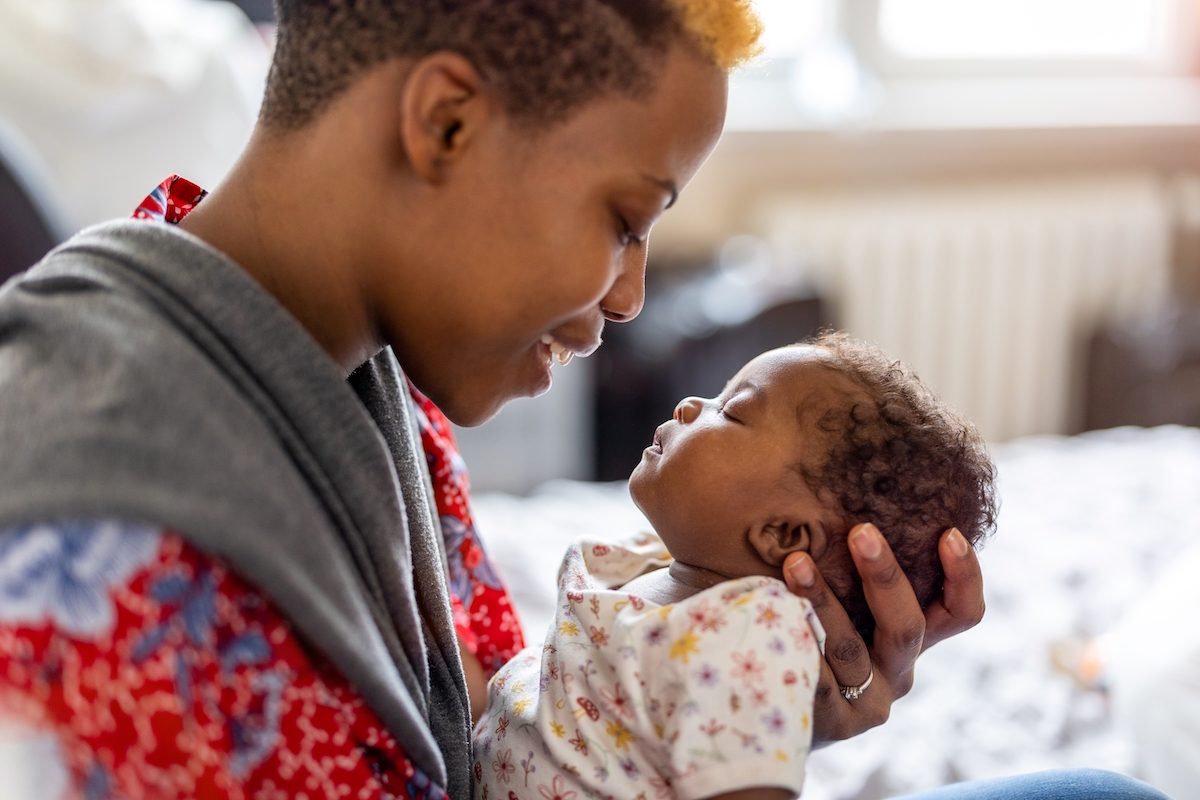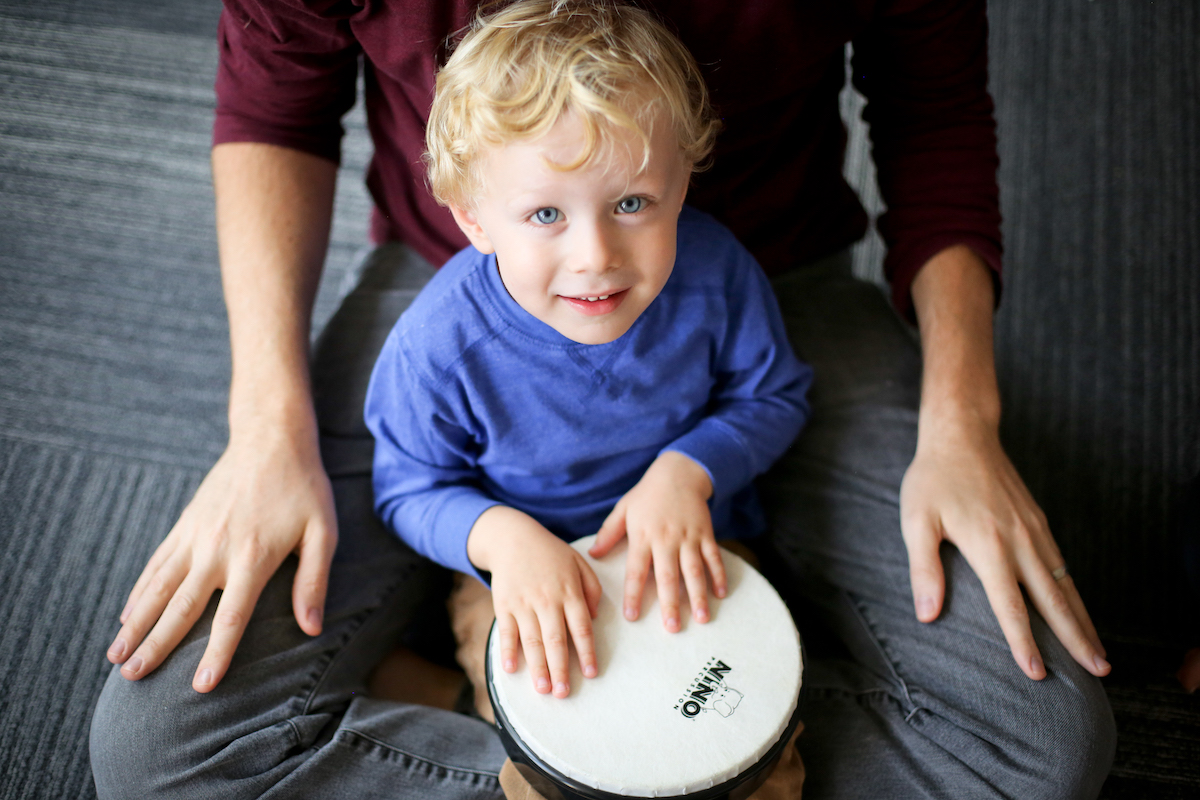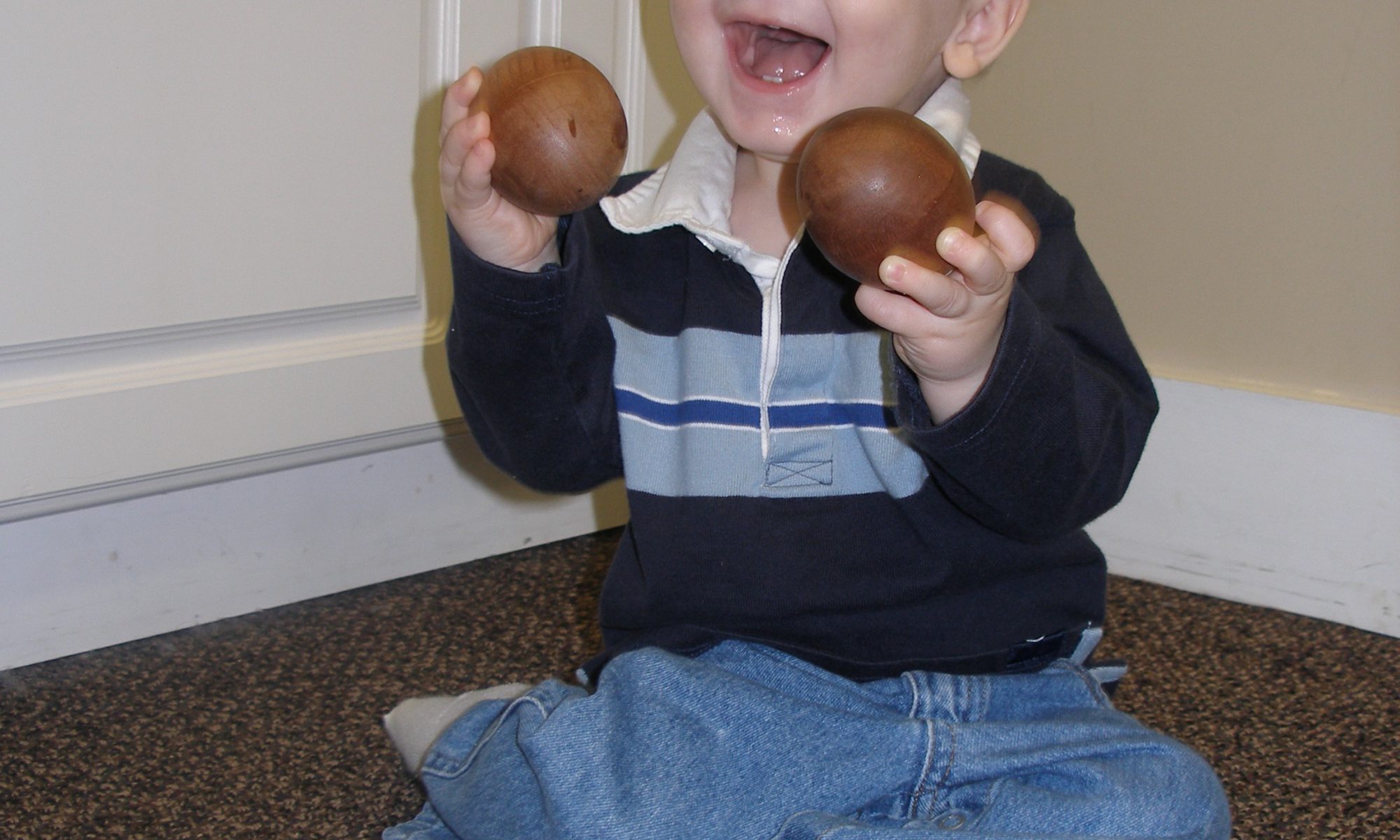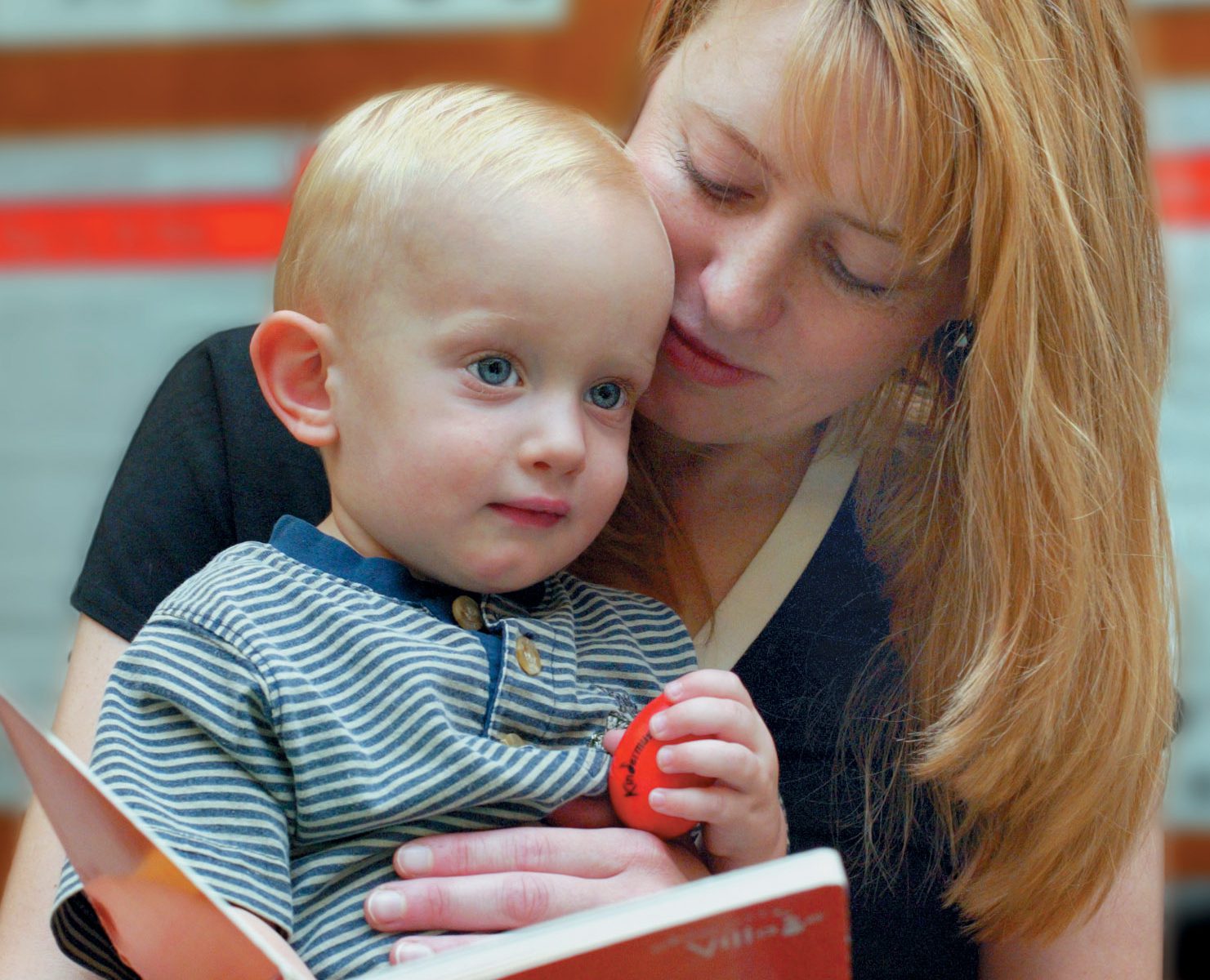Did you know that babies can’t focus on or imitate sounds in a low pitch? It’s OK to sing your favorite low-pitched song to your little one, but mixing in high-pitched kid songs in a head voice is critical to boosting young children’s natural development.
Continue reading “Why High-Pitched Kid Songs Belong on Your Playlist”Newborn Bonding: How Infant Music Classes Connect Parent and Baby
From the benefits of skin-to-skin to rocking to massage, there is so much conversation around newborn bonding. And that’s a good thing!
Here’s one idea you may not have heard of…infant music classes.
First, let’s look at the why, when, and how of this critical part of early development.
Continue reading “Newborn Bonding: How Infant Music Classes Connect Parent and Baby”Through a Nana’s eyes
Special thanks to Studio 3 Music, the world’s largest Kindermusik program, for sharing this special post by from their blog with us. The author, Colleen, is not just a grandmother; she’s also a licensed Kindermusik teacher at Studio 3!
It’s no wonder Grandmothers are afforded such a high level of respect in so many cultures: we are survivors! We have borne children, raised them to adulthood and now stand ready to assist a whole new batch of babies. Our hair a little grayer (not that anyone else will actually KNOW that fact), our gait a little slower, and perhaps our speech a bit more selective, having learned a thing or two along the way….hopefully!Each week I gather with a group of grandmothers much as I gathered with other moms when my children were young. Oh, the special companionship we share! We compare stories and pictures, laugh until we cry, cry until we laugh. We celebrate remembered successes and occasionally can’t resist commiserating over the things we wished we’d done differently. But in general, we relish the richness a new generation of babies brings to our lives.
Being one of the newer members of the Studio3 teaching team, I also have the special privilege of being the oldest and the one with the most (make that “only”!) grandchildren. I could never have imagined even two years ago that my days would be spent so delightfully singing and skipping, hopping and bouncing, dancing and snuggling with little ones while learning a plethora of nursery rhymes, not to mention dozens of dances, silly songs and stories. I feel I’ve been granted a rare and wonderful privilege.
But, of course, the best part is the children….and we Nanas and Papas see them very differently than Mommies and Daddies. Grandparent’s eyes are somehow different than parent’s eyes, probably because they are old and practiced. We have seen how very quickly a little one pulls his way up to wobbly knees, quickly followed by toddling feet that all too soon make way for bicycle pedals. Babies are not babies for long. Toddlers are not toddlers for long. Children are not children for long.
In the midst of the morphing the moments seem to stretch on forever! Will they never sleep through the night? Will he ever use a spoon? Are diapers forever? (Well, that Depends, I guess!) It’s hard to take the long view when the short view involves such intensity.
I guess that’s one of the rewards of grandparenting. We have seen the long view and discovered that it arrives all too soon! I share with you a little poem someone took the time to embroider and frame as a gift for me when I was a young mom, in hopes you will pay it more heed than regrettably I, especially the last stanza. Credited to Ruth Hamilton, it first appeared in the Ladies Home Journal in 1938 (before even MY time!).
Babies Don’t Keep
Mother, oh Mother, come shake out your cloth,
Empty the dustpan, poison the moth,
Hang out the washing and butter the bread,
Sew on a button and make up a bed.
Where is the mother whose house is so shocking?
She’s up in the nursery, blissfully rocking.
Oh, I’ve grown shiftless as Little Boy Blue
(Lullaby, rockaby, lullaby loo).
Dishes are waiting and bills are past due
(Pat-a-cake, darling, and peek, peekaboo).
The shopping’s not done and there’s nothing for stew
And out in the yard there’s a hullabaloo
But I’m playing Kanga and this is my Roo.
Look! Aren’t her eyes the most wonderful hue?
(Lullaby, rockaby, lullaby loo).
The cleaning and scrubbing will wait till tomorrow,
For children grow up, as I’ve learned to my sorrow.
So quiet down, cobwebs. Dust go to sleep.
I’m rocking my baby and babies don’t keep.
All about the beat
 In all Kindermusik classes, there is always emphasis on hearing, feeling, moving, and even “seeing” a steady beat. It may seem very elementary, but it is essentially the cornerstone of music.
In all Kindermusik classes, there is always emphasis on hearing, feeling, moving, and even “seeing” a steady beat. It may seem very elementary, but it is essentially the cornerstone of music.
More importantly, steady beat plays a huge importance in our speech, movement, thoughts and verbal organisation. From a baby’s first hesitant steps, he slowly finds his pace and soon starts to walk steadily and confidently. Our preschoolers who have a strong sense of beat would be able to use the scissors more skillfully. Ever watch a basketball game? The steady dribble of the ball before it is tossed smack into the basket require an acute sense of beat and timing. A master chef needs to have a command of steady beat in his knife skills. Even writers rely on a sense of steady beat and rhythm in their prose to produce a good read.
Because it is such a fundamental element, parents and teachers often do not give sufficient attention to the development of this very important underlying skill – a strong sense of beat. The consequence of insufficient steady beat experiences in early years can result in poor physical coordination, halting speech (in some cases, stuttering), and even weakness in thought flow. Would you have imagined that something so apparently a strictly musical characteristic can have such bearing on so many areas of our functioning?!
Here are some simple and fun activities that you can do with your child at home to reinforce the concept sense of steady beat:
Movement – Turn on the music and pretend to be a marching band. March, stomp or jump to the music. For younger babies, put them on your lap and bounce to a steady beat or dance with them around the room to the steady beat of the music.
Instrument play – Use the instruments from your home materials or make your own. An old pot and spoon will make a very fun ( and loud!) drum. Practice keeping a steady beat along with the music.
Reading – Nursery rhymes are a great way to introduce steady beat. Clap or tap along as you recite your child’s favourite rhymes.
Originally written by Chiat Goh.
Why Music Supercharges Early Brain Development
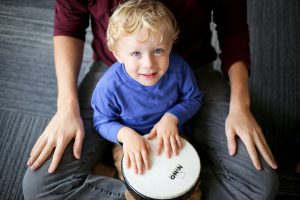
Research shows that listening and playing along with music is one of the few activities that fully supports early brain development.
How?
It engages both hemispheres of your child’s brain. Add the fine motor coordination it takes to hold an instrument and tap in time with the music, and your child is working on the hand-eye coordination and finger strength that’s necessary to hold a pencil, tie a shoe, use scissors, and dribble a basketball later on.
Early Brain Development Tips
For your baby – Gently tap the steady beat on your baby’s hand, foot, or knee with an instrument.
For your toddler – Invite your child to use the instrument to tap on his own toes, knees, or even a tummy!
For your preschooler or big kid – Preschoolers and older kids can march around the house in a musical parade.
Musical Brain Boosting Tools
Did you know Kindermusik has a free kid-friendly app? Download it today on Google Play or from the App Store, and choose from themed playlists (like colors, nap time, and food), tappable instrument play, and more!
Originally compiled by Kindermusik educator Theresa Case. Theresa’s program, Kindermusik at Piano Central Studios in Greenville, SC, USA, is proudly among the top 1% of Kindermusik programs worldwide. Search for a class with Theresa or find a virtual or in-person class wherever you are.
The music in your head: How did it get there?
 Music education is a vital part of a child’s life. Research shows that our abilities to sing in tune, move to a steady beat and yes, hear music in our heads, are all formed by the time we are 8- or 9-years old. That doesn’t mean you can’t learn to sing or dance or play the piano after the third grade, but the learning windows for musical aptitudes do begin to close.
Music education is a vital part of a child’s life. Research shows that our abilities to sing in tune, move to a steady beat and yes, hear music in our heads, are all formed by the time we are 8- or 9-years old. That doesn’t mean you can’t learn to sing or dance or play the piano after the third grade, but the learning windows for musical aptitudes do begin to close.
Do you ever hear a song in your head over and over again? Can you imagine not being able to hear music this way? Audiation, the ability to hear music when no musical sound is present, is an acquired skill. Similar to thinking thoughts without talking aloud, when you audiate, you internalize and “think” music. To practice audiation with your child, leave off the last word of a favorite song. Stop completely. Observe and listen to your child. What is the reaction? When you play this game with familiar songs, you are engaging your child’s ability to think and “speak” with you musically.
Were you lucky enough to have wonderful parents who sang to you all the time? Did you sing endless rounds of “She’ll Be Comin’ Round The Mountain” when you went on vacation? Repetition is a critical part of your child’s growth and development between the ages of birth and seven. Repetition aids in strengthening the neural pathways in the brain. So when your child wants you to “Read it again, Mommy!” or “Play that song again, Daddy!”, do it!!!
Babies are innately musical. They respond to music and sound in utero. Carla Hannaford, author of Awakening the Child Heart, tells us that hearing and language begin in utero and become the first window to the material world as the embryo physically reacts to sound 23 days after conception. Sound becomes the organizer of our physical structure and later, via the mother’s coherent heart rhythm, gives us the patterns on which to form a coherent understanding of patterns within our world.
People often ask, “What do you do with an infant in a music class?” Babies can be soothed with music. Brain development is stimulated by music. A Kindermusik Village class, for example, provides a rich environment of music, movement, language and touch for babies newborn to 18 months. This combination of music and movement stimulates the Vestibular System, the fluid in the brain. According to Dr. Alfred Tomatis, without a fully developed Vestibular System that allows us verticality and balance, language and learning become difficult. Language development begins with movement and is supported with interactive communication and music. Hannaford points out that early music education, including the interplay of music, movement and sound, is key to developing language, math, relational and learning skills, as well as creativity.
Toddlers love to clap and pat to the steady beat of favorite tunes. Steady beat is the unchanging, underlying beat that pulses through every top-10 tune on the radio. Different from rhythm – a combination of various short and long sounds – steady beat is what we tap our toes, pencils and imaginary drums to. For many toddlers, steady beat is an innate ability nurtured with lots of opportunity to practice. For others, it is a skill that can be learned through practice. The ability to keep a steady beat is a gift that we all want our children to have. A study showed 100% of first string professional football players can move their bodies to a steady beat. Moving to a steady beat develops a sense of timing and the ability to organize and coordinate movements like walking, dribbling a basketball, driving and using scissors. Not true for 2nd string. Kindermusik classes provide many opportunities for toddlers to play instruments and move to a steady beat and parents are educated about ways to keep music alive at home.
Preschoolers are exploding with ideas and questions. Creative music and movement provide an outlet for the imaginary characters that live inside a child. 3- and 4-year olds flourish in an environment where there is music, movement and an opportunity for them to contribute ideas. In a Kindermusik Imagine That! class, a child can explore voice and ideas, add instruments to songs and rhymes, act out enticing characters and grow socially while interacting with peers.
For a kindergarten or first grade child, reading readiness is an important issue. I often imagine how it would have been to have the language of music and the English language concurrently integrated into my life: learning to read and write music while learning to read and write language.
Kindermusik provides a whole child approach to music education. Children move and sing, play musical games, learn about music in other cultures, talk about and listen to the instruments of the orchestra, develop their discriminative listening skills, build self-esteem through group interaction and music making, begin to read and write basic musical notation and much more.
I often get calls from eager parents, ready to spend gobs of money on private music lessons for their 3-, 4- and 5-year olds. I first ask them, how are the children’s fine motor skills? Are they reading? How big are their hands? Are they ready to practice at least 20-30 minutes each day? By the time children complete a 2-year Kindermusik class, they have played a pre-keyboard instrument, a simple string instrument and a wind instrument. They are eager to pursue private lessons and have more staying power!
When you choose a music program, make sure it is compatible with you and your child. Be prepared to be an active participant and supporter of your child’s music experience. It could be the best investment you ever make.
Music turns kids on. So turn it up!
Thanks to Stephanie Bartis, M.M., for sharing this great article, orginally written for the Art of Well Being. Stephanie is a member of Kindermusik’s Maestro Conductor Circle, which distinguishes her and her studio, Bartis Creative Studio, as among the top 1% Kindermusik programs worldwide.
New mommies’ brains grow bigger
The following post was shared by Kindermusik educator Analiisa Reichlin.
I always said that I lost brain cells with each child I delivered. It’s been my excuse over the last 12 years for all the information and appointments and tasks that seem to fall out of my head. However, some recent research I read seems to contradict that idea.
A recent Science Daily article says this, “Motherhood may actually cause the brain to grow, not turn it into mush, as some have claimed. Exploratory research published by the American Psychological Association found that the brains of new mothers bulked up in areas linked to motivation and behavior, and that mothers who gushed the most about their babies showed the greatest growth in key parts of the mid-brain.”
The authors of the study proposed the idea that all the hormonal changes after birth allow mother’s brains to reshape in response to their baby, and the instinct and drive mothers have to take care of their infant is the result of brain growth.
The researchers performed brain scans on women several weeks after birth, and again at 3 to 4 months post partum. They found that the mothers who most enthusiastically described their infants as wonderful, perfect, precious, beautiful, etc., were significantly more likely to have growth in the gray matter of their brains linked to maternal motivation, rewards and the regulation of emotions.
What made the authors believe that this brain growth was linked to motherhood was the fact that in adults, gray matter volume doesn’t normally transform over a few months without significant learning, brain injury or illness, or major environmental change.
So the questions arose. Does the constant touching, holding, cuddling, between a mother and baby cause her brain to “orchestrate a new and increased repertoire of complex interactive behaviors” with her baby?
Does growth in the brain’s “motivation” area lead to more nurturing by the new mommy, which in turn helps her baby thrive? Does behavior change the brain, or brain change behavior?
Finally, is it possible that post-partum depression reduce the same areas in the brain that grew in the non-depressed moms? Is there something in these findings that could help them?
More research is definitely needed. But these results are interesting, to say the least. So in the meantime, go ahead enthusiastically gush about your baby to everyone!
Special thanks to Studio 3 Music for allowing us to share this great post from the Studio 3 Music blog. Studio 3 Music in Seattle, Washington, the world’s largest Kindermusik program.
Good taste in books
 Literacy begins early, with nothing more than simply spending time with a book. Even if your baby puts the book in her mouth while you read, she absorbs the sounds of your words, the action of you turning the page, and the pleasure you derive from reading.
Literacy begins early, with nothing more than simply spending time with a book. Even if your baby puts the book in her mouth while you read, she absorbs the sounds of your words, the action of you turning the page, and the pleasure you derive from reading.
The first time your little one points to a picture in a book, she’s understanding the concept of symbols – the idea that the words and pictures represent objects and ideas. A child’s motivation to learn about and use symbols grows as she realizes that this is how she can make her needs and thoughts known to others.
When it comes to choosing books, recent research shows that children who have been exposed to nursery rhymes and lyrical stories in their younger years become better readers and are more successful in school.
Here are some of our favorite tips for developing good taste in books.
Your baby: Spend time with your baby and an open book. Point to the pictures and talk about what you see. Even if your child doesn’t understand a single word, she’ll absorb your love of books and reading.
Your toddler: Now your child can start adding sound effects when you read together. Choose stories with animals so your toddler can imitate their sounds and movements.
Your preschooler: Your little one is now ready to make up his own stories. He can also use a favorite story as the basis for his own pretend play. Help your preschooler make his own book using a favorite song or family photos. Share this “published” work with the whole family!

